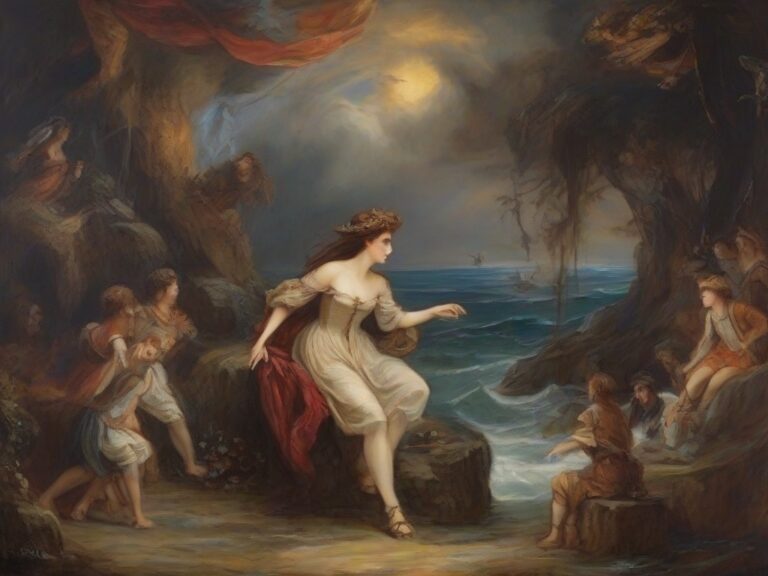Unveiling the enigmatic realms of love, revenge, and redemption, ‘The Tempest’ by William Shakespeare has etched its name into the annals of literary greatness. As the last masterpiece crafted by the immortal bard, this timeless play continues to captivate hearts and stir minds even centuries after its creation. Delving into a world shrouded in mystery and wonder, ‘The Tempest’ transports readers to a remote island where illusion meets reality, and where the tides of fate crash against the shores of human nature. In this compelling summary, we embark on a voyage of fascination, uncovering the hidden depths of Shakespeare’s literary genius.
Join us as we navigate the tempestuous waters of this enchanting masterpiece and reveal the profound insights it bestows upon our contemporary lives. Prepare to be spellbound as we unravel an intriguing open loop, one that will leave you craving for more as we explore the transformative power of art in this extraordinary tale.
The Tempest by William Shakespeare: Full Book Summary
Once upon a time, in a magical land far away, there was an enchanted island ruled by a powerful sorcerer named Prospero. Prospero possessed great knowledge of magic and nature, and he lived on the island with his young daughter Miranda.
Miranda had never known the outside world because they had been exiled to the island when she was just a baby. Prospero, you see, used to be the Duke of Milan. But his own brother, Antonio, had conspired with Alonso, the King of Naples, to overthrow him and take his throne. They left Prospero and Miranda stranded on the island, all alone.
But Prospero was not an ordinary man. He had studied the secret arts of sorcery and managed to summon a powerful spirit called Ariel to serve him. Ariel could change into any form and perform incredible feats of magic. Prospero promised Ariel that if he helped him, he would eventually set him free. This gave Ariel hope, and thus the spirit became Prospero’s loyal companion.
One day, Prospero used his magic to conjure up a storm, a tempest, which caused a ship carrying his brother Antonio, King Alonso, and other nobles from Milan to be wrecked on the shores of the island. Prospero had planned this carefully, for he wanted revenge on those who had betrayed him.
Among the survivors was Alonso’s son, Prince Ferdinand. As he wandered through the island, he came upon Miranda, and they instantly fell deeply in love. Prospero, knowing that true love cannot be forced, watched them cautiously but allowed their love to blossom.
While Ferdinand and Miranda spent time together, Ariel, being invisible, played tricks on the other survivors. He led them through the island, separated them, and caused them to become lost. Prospero observed their confusion and felt a sense of satisfaction.
Meanwhile, on the other end of the island, drunken and foolish, there were two other survivors named Stephano and Trinculo. Along with Caliban, a strange creature who was the son of the witch Sycorax and the rightful ruler of the island before Prospero arrived, they got into antics and plotted to overthrow Prospero. They believed that with his powers, they would become the new rulers of the island. Little did they know that they would soon face the consequences of their foolishness.
Prospero, aware of their evil intentions, used his magic to create a magical banquet. As the survivors gathered to enjoy the feast, Prospero appeared before them and revealed his true identity. He scolded Antonio for his treachery and showed Alonso the consequences of his actions.
Seeing his brother, Antonio felt deep remorse and begged Prospero for forgiveness. Prospero, after witnessing his brother’s genuine regret, forgave him and embraced him as a brother once again. He also showed Alonso that his son Ferdinand was alive and well, and that he was deeply in love with Miranda.
Having achieved his revenge and reconciled with his brother, Prospero realized that true power lies not in seeking vengeance but in forgiveness. He understood that magic should be used for good and that he no longer wanted to be trapped on the island.
Prospero made amends with Caliban, recognizing that the creature was innocent and simply influenced by the two foolish survivors. He told Caliban that although he still held rightful control over the island, from that day forth, he would be a free man.
With the help of Ariel, Prospero summoned a magical spirit to guide the survivors safely back to their homeland. He bid farewell to the island and promised Miranda that she would soon see civilization and meet her fellow countrymen.
As Prospero sailed away from the enchanting island with Miranda and all the survivors, he released Ariel from his service as promised. Ariel, feeling a sense of freedom and gratefulness, joyfully soared into the heavens and disappeared.
And so, the tempest had come to an end, and Prospero’s spell over the island was lifted. Prospero became the Duke of Milan once again and led a life filled with love, forgiveness, and the knowledge that true power resides in the heart.
And the story of The Tempest reminds us all, young and old, that revenge may seem tempting, but forgiveness and redemption are the true paths to happiness and peace.
The Tempest: Key Themes
“The Tempest” is a play written by William Shakespeare, believed to be one of his last works. It tells the story of Prospero, the rightful Duke of Milan, who has been usurped by his brother Antonio and left to drift at sea with his daughter Miranda. Stranded on a deserted island, Prospero uses his magic powers to manipulate the elements, conjure spirits, and orchestrate a tempest that brings his enemies to the island.
1. Power and Colonialism: One of the central themes of “The Tempest” is the exploration of power dynamics and colonialism. Throughout the play, Prospero is portrayed as a powerful figure who exercises control over others on the island, whether it is the spirit Ariel or the savage Caliban. This power dynamic echoes the real-life colonization of the Americas during Shakespeare’s time, where European powers took control over native lands and people. The play raises questions about the ethical implications of wielding power over others and the consequences it may have.
2. Forgiveness and Redemption: Another significant theme in “The Tempest” is the idea of forgiveness and redemption. Prospero, despite being wronged by his brother and subjected to years of exile, ultimately chooses to forgive his enemies and orchestrate their reconciliation. He realizes that revenge will not bring him happiness or peace, and he uses his powers to bring about forgiveness and redemption. This theme highlights Shakespeare’s belief in the power of forgiveness and the potential for personal growth and transformation.
3. Illusion and Reality: “The Tempest” also explores the concept of illusion and reality. Prospero, through his magic, creates illusions such as the tempest and fairy-like creatures that inhabit the island. These illusions often serve as a means to manipulate or test the characters. The play raises questions about the nature of reality and the role of perception in shaping our understanding of the world. It suggests that our perception of reality may be distorted by our desires, fears, and beliefs, and that true understanding requires digging beneath the surface of appearances.
Overall, “The Tempest” delves into themes of power and colonialism, forgiveness and redemption, and illusion and reality. Through the characters and their interactions, Shakespeare explores the complexities of human nature and the fundamental questions of our existence.
The Tempest: Characters
1. Prospero: The protagonist and rightful Duke of Milan, Prospero is a powerful magician. With his long, silver hair and wise, piercing blue eyes, he cuts an imposing figure on the enchanted island where the story takes place. Armed with a magical staff and book of spells, he orchestrates the events in the story with meticulous precision. Despite his innate seriousness, he occasionally indulges in melodramatic gestures, like twirling his mustache and muttering ancient incantations.
2. Miranda: Prospero’s daughter, Miranda, is a beautiful and innocent young woman. With her flowing golden locks and luminous green eyes, she embodies purity and grace. Raised on the uninhabited island, her only companions were Prospero and spirits. Miranda is often depicted singing and frolicking with the ethereal creatures of the island, creating an enchanting atmosphere wherever she goes. She possesses an enchanting innocence and curiosity about the outside world.
3. Ariel: A mischievous and playful elemental spirit, Ariel is Prospero’s devoted servant. As a shape-shifter, Ariel can take on various forms, often appearing as an elegant sylph-like creature with shimmering iridescent wings. Despite being a captive spirit, Ariel delights in manipulating events on the island to suit Prospero’s wishes. Blessed with a mischievous sense of humor and a quick wit, Ariel often finds himself tangled in amusing situations while ensuring Prospero’s commands are carried out.
4. Caliban: Portrayed as a primitive and monstrous being, Caliban is the son of the deceased witch, Sycorax. With his hulking frame, scaly patches of skin, and wild, unruly hair, Caliban exudes a fearsome appearance that belies his misunderstood nature. Despite his grotesque exterior, Caliban possesses a poetic soul and yearns for freedom and acceptance. Known for his dry sense of humor and penchant for rhyming, he often punctuates tense moments with ironic one-liners.
5. Ferdinand: A young nobleman, Ferdinand is shipwrecked on the island and becomes infatuated with Miranda at first sight. With his chiseled jawline, sun-kissed hair, and eyes that seem to shimmer like the ocean, he personifies the ideal romantic hero. Ferdinand’s love for Miranda drives him to prove himself worthy of her hand, engaging in grueling tasks such as moving logs and carrying heavy burdens to gain her father’s approval. Despite these feats, he often finds himself being clumsily smitten under Miranda’s watchful gaze.
6. Antonio: Prospero’s deceitful younger brother, Antonio usurped his brother’s dukedom with the assistance of Alonso, the King of Naples. With his sharp, hawk-like features and shifty eyes, Antonio exudes a sense of cunning and ruthlessness. Antonio is not one to shy away from a villainous monologue or indulging in wicked acts, making him the quintessential antagonist of the story. His fondness for power-driven schemes is only matched by his knack for sarcastic one-liners, often leading to his own undoing.
7. Alonso: The King of Naples, Alonso bears the weight of guilt and grief for his past actions. With his silver crown perched atop greying hair and weary eyes, Alonso is haunted by the loss of his son, whose supposed death drives him to desperation. Struggling with remorse, he often wrestles with an internal moral compass, making him a complex and sympathetic character. Known for his passionate outbursts, he sometimes lacks grace in tense situations, leading to comically awkward circumstances.
8. Sebastian: Alonso’s conniving and treacherous brother, Sebastian is always in pursuit of personal gain. With his sharp features, including a thin mustache and perfectly coifed hair, he embodies the quintessential schemer. Sebastian enjoys playing devil’s advocate and teasing his companions, often instigating conflict and slyly observing the chaos he creates. His quick wit and sardonic remarks make for entertaining banter, even under the gravest of circumstances.
9. Stephano: A foolish and drunken butler, Stephano provides comic relief throughout the story. With his portly frame, unkempt facial hair, and a perpetually sloshed expression, he is a figure of ridicule. Despite his seemingly limited intellect and inebriated state, Stephano manages to find himself at the center of absurdly hilarious situations, often fueled by his own inflated self-importance. Nevertheless, his loyalty to Caliban as they conspire to overthrow Prospero adds a touch of endearing charm to his character.
The Tempest: Symbols
1. The Tempest: The titular tempest is one of the most prominent symbols in the play. It is a violent storm created by the sorcerer Prospero, who uses his magical powers to conjure it. The tempest serves as a catalyst for the events of the play, causing a shipwreck on the island where Prospero and his daughter Miranda reside. Symbolically, the tempest represents the disruption and chaos that can occur when natural forces are unleashed, paralleling the emotional and psychological turmoil experienced by the characters throughout the play. The tempest also serves as a metaphor for Prospero’s desire for revenge and his attempts to bring about a reckoning with his enemies.
2. Ariel: Ariel, the spirit servant of Prospero, is a powerful symbol in The Tempest. Ariel is often portrayed as an ethereal being, with the ability to shape-shift and manipulate the elements. Though capable of causing great destruction, Ariel is a benevolent spirit who ultimately aids Prospero in achieving the restoration of order. Symbolically, Ariel represents the power of art and creativity to bring about change and transformation. Ariel’s imprisonment by the witch Sycorax also serves as a reminder of the constraints placed upon imagination and the potential for liberation through the arts.
3. Caliban: Caliban, the offspring of the witch Sycorax, is another significant symbol in The Tempest. Caliban is often portrayed as a deformed monster, seen as brutish and savage by the other characters. His characterization as an “other” reflects the prevalent colonial attitudes of the time, as he is viewed as a subhuman creature and enslaved by Prospero. Caliban represents the oppressed and colonized people, giving voice to their struggles against imperialistic powers. His desire for freedom and control over his own destiny underscores the larger themes of power, colonialism, and resistance in the play. Through Caliban, Shakespeare challenges prevailing notions of race and identity, highlighting the complexities of human nature.
The Tempest: Culture Impact
“The Tempest” by William Shakespeare is a timeless masterpiece that has left an indelible mark on both the literary world and popular culture. Since its first performance in the early 17th century, this whimsical play has captured the hearts of audiences and continues to be celebrated for its cultural impact.
Historically, “The Tempest” has played a significant role in shaping the landscape of English literature. It is Shakespeare’s final solo work, believed to be written in 1610-1611. The play beautifully combines various elements including romance, comedy, tragedy, and the supernatural in a way that revolutionized the concept of theatrical storytelling. This innovation in dramatic structure and genre blending has since influenced countless playwrights and authors throughout history.
Despite its initial mixed reception, “The Tempest” has become one of Shakespeare’s most beloved works. Its enduring popularity can be attributed to various factors. One of its achievements lies in its ability to entertain and captivate audiences across generations. From its enchanting characters like the magical Prospero, the mischievous spirit Ariel, and the monstrous Caliban, to its intricate plot of betrayal, forgiveness, and redemption, “The Tempest” has always served as a compelling tale that resonates with diverse audiences.
Furthermore, the play’s exploration of profound themes such as colonialism, identity, power dynamics, and the human condition has contributed to its cultural impact. “The Tempest” tells the story of a magician named Prospero who is stranded on a remote island and establishes dominion over its inhabitants, echoing the struggles faced during the era of European exploration and colonization. This exploration of complex social issues has led to numerous interpretations and critical analysis over the years, making “The Tempest” a subject of intense academic study.
In addition to its serious themes, “The Tempest” also embraces moments of comedic brilliance. From the humorous banter between shipwrecked sailors, Stephano and Trinculo, to the scene-stealing antics of the bumbling jester, Touchstone, the play offers lighthearted relief amidst its deeper undertones. These comedic elements have not only elicited laughter throughout history, but also sparked inspiration for comedic traditions that we still enjoy today.
Outside the realm of literature, “The Tempest” has permeated popular culture in remarkable ways. Countless adaptations, from stage performances to films, have paid homage to this timeless play. Notable film adaptations include Julie Taymor’s visually stunning rendition in 2010, starring Helen Mirren as Prospera, a gender-switched version of the original character. Additionally, iconic quotes such as “O brave new world, that has such people in it!” have become embedded in the cultural lexicon, even referenced in modern works of fiction, music, and art.
“The Tempest” continues to transcend time and retain its relevancy in both academic and popular spheres. Its rich tapestry of themes, unforgettable characters, and Shakespeare’s masterful storytelling have ensured its enduring presence. Whether it be through its contributions to theatrical innovation, its exploration of complex social issues, or its ability to bring joy and laughter, “The Tempest” remains an invaluable cultural achievement that will continue to shape and inspire generations to come.
FAQs
1. Who is the author of “The Tempest”?
“The Tempest” is a play written by William Shakespeare.
2. When was “The Tempest” written?
“The Tempest” is believed to have been written between 1610 and 1611.
3. What is the plot summary of “The Tempest”?
The Tempest is a play about Prospero, a former duke of Milan who was exiled to a remote island by his brother Antonio and the king of Naples Alonso. Prospero uses his magic to conjure a storm that shipwrecks Alonso and his company, who were returning from the wedding of Alonso’s daughter Claribel in Tunis. Prospero intends to use his magic to restore his dukedom and secure the marriage of his daughter Miranda to Alonso’s son Ferdinand, who also survived the shipwreck. Along the way, he has to deal with the rebellions of his slave Caliban, who is the son of a witch named Sycorax, and his spirit servant Ariel, who longs for freedom. He also has to foil the plots of Antonio and Alonso’s brother Sebastian, who plan to kill Alonso and take over his kingdom, and of Caliban, who allies with two drunken sailors, Stephano and Trinculo, to overthrow Prospero. The play ends with Prospero forgiving his enemies, freeing Ariel, renouncing his magic, and preparing to return to Milan with his daughter and son-in-law.
4. What are the main themes explored in “The Tempest”?
The Tempest explores several themes, such as power, magic, forgiveness, and colonialism. Power is a central theme, as the play examines the different forms and sources of power, such as political, magical, and natural. The play also questions how power should be used and who has the right to wield it. Magic is another theme, as the play depicts the wonders and dangers of Prospero’s art, and how it affects his character and his relationship with others. Forgiveness is another theme, as the play shows how Prospero learns to overcome his desire for revenge and reconcile with his enemies. Colonialism is another theme, as the play reflects the historical context of European exploration and exploitation of the New World, and the issues of race, culture, and identity that arise from it.
5. What is the significance of the character Caliban in “The Tempest”?
Caliban is the son of Sycorax, a witch who ruled the island before Prospero arrived. He is a half-human, half-monster creature who serves Prospero as a slave. He hates Prospero for taking over his island and tries to rebel against him with the help of Stephano and Trinculo, two drunken sailors. He also attempts to rape Miranda, Prospero’s daughter, and is punished by Prospero’s magic. Caliban represents the colonized native who resists the colonizer’s domination.
6. What is the meaning of the epilogue in The Tempest?
The epilogue is the final speech that Prospero delivers to the audience after he has resolved all the conflicts and restored order. In the epilogue, Prospero asks the audience to forgive him for his wrongs and to free him from the island by applauding. He also renounces his magic and says that he will retire to Milan. The epilogue is widely interpreted as Shakespeare’s farewell to the theater, as The Tempest is believed to be his last play.
7. What is the role of Ariel in The Tempest?
Ariel is a spirit of air who serves Prospero as his loyal agent. He uses his magic to carry out Prospero’s commands, such as creating the storm, tormenting Prospero’s enemies, and arranging the meeting of Ferdinand and Miranda. He also reports to Prospero the actions and feelings of the other characters. Ariel longs for his freedom, which Prospero promises to grant him once his plans are accomplished. Ariel represents the positive and benevolent aspect of Prospero’s magic, as opposed to the negative and malevolent aspect of Caliban .
8. How does The Tempest relate to colonialism?
The Tempest reflects the historical and cultural context of colonialism, as it was written during the age of exploration and expansion of the European powers. The play depicts the encounter between Prospero, a European colonizer, and Caliban, a native inhabitant of the island. The play explores the issues of race, culture, and identity that arise from this encounter, and questions the legitimacy and morality of Prospero’s rule over the island and its people. The play also shows the influence of colonialism on the imagination and representation of the New World, as it portrays the island as a place of wonder, mystery, and danger .
9. What is the significance of the masque in The Tempest?
The masque is a theatrical form that involves music, dance, and allegorical characters. In The Tempest, Prospero conjures a masque in Act IV, scene i, to celebrate the betrothal of Ferdinand and Miranda. The masque features the goddesses Iris, Ceres, and Juno, who bless the couple and wish them happiness and fertility. The masque also includes a dance of nymphs and reapers, who represent the harmony of nature. The masque is significant because it shows Prospero’s artistic and creative power, as well as his paternal love for Miranda. It also foreshadows the resolution and reconciliation that will occur in the final act .










